While traveling, I am often asked what my home country has to offer. I used to say “nothing”. That´s a lie. Norway has nature. Stunningly beautiful nature. In abundance. Norway is a hiker’s paradise and known for its long fjords winding their way through majestic mountains and green valleys with breathtaking views. I am sure you find some of the world’s best hikes in Norway.
Last time I was living in Norway, I made sure to go hiking as much as possible to really indulge myself in the natural wonder I was born into. I had never been hiking much before I started traveling the world. Nonetheless, when I explored new countries, I loved going hiking to discover the outdoors of the destination.
It was first when I traveled to Milford Sound in New Zealand that I realized how spectacular the Norwegian nature actually is. I remember standing on the boat surrounded by other travelers that stood completely breathless by the beauty around us.
I was somehow disappointed. I had expected more. This fjord was gorgeous, but it couldn’t measure to the ones in my home country.
That’s how I fell in love with the Norwegian outdoors. From the other side of the world. I never answered “nothing” again when someone asked me what Norway has to offer.
To finally show the beauty of Norway to the world, I asked fellow travel bloggers and outdoor enthusiasts about their favorite hikes in Norway. But first, some useful tips for hiking in Norway.
Disclosure: This post may contain affiliate links. That means that if you make a purchase through one of those links, I will get a small commission at no extra cost to you. If you have any questions about these services or products, feel free to ask me.

Make a difference!
Plant trees to create habitat for animals from the convenience of your home
The Norwegian Mountain Code
Before we get going with the hikes, there are some rules you should assume before you go hiking in Norway. They are called the Norwegian Mountain Code. These are a set of 9 rules every Norwegian learn at school, and that they all respect when they enjoy the outdoors.
Why do they need rules to go hiking, you might be asking? Are the Norwegians that rigid that they need rules for everything? Well in some ways they might be, but that’s a different story.
You might know that Norwegian weather conditions are extremely unpredictable. Some days you can experience all four seasons in only a few hours. Together with mighty nature, this can make an unfortunate combination.
That’s why the Norwegian Mountain Code is meant as a guideline to stay safe when you go trekking in Norway.
So, before you check out some of the best hikes in Norway, read through the following set of rules:
- Plan your trip and inform others about the route you have selected
- Adapt the planned routes according to ability and conditions
- Pay attention to the weather and the avalanche warnings
- Be prepared for bad weather and frost, even on short trips
- Bring the necessary equipment so you can help yourself and others
- Choose safe routes, recognize avalanche terrain and unsafe ice
- Use a map and a compass, always know where you are
- Don´t be ashamed to turn around
- Conserve your energy and seek shelter if necessary
You can find more information about the Norwegian Mountain Code here.
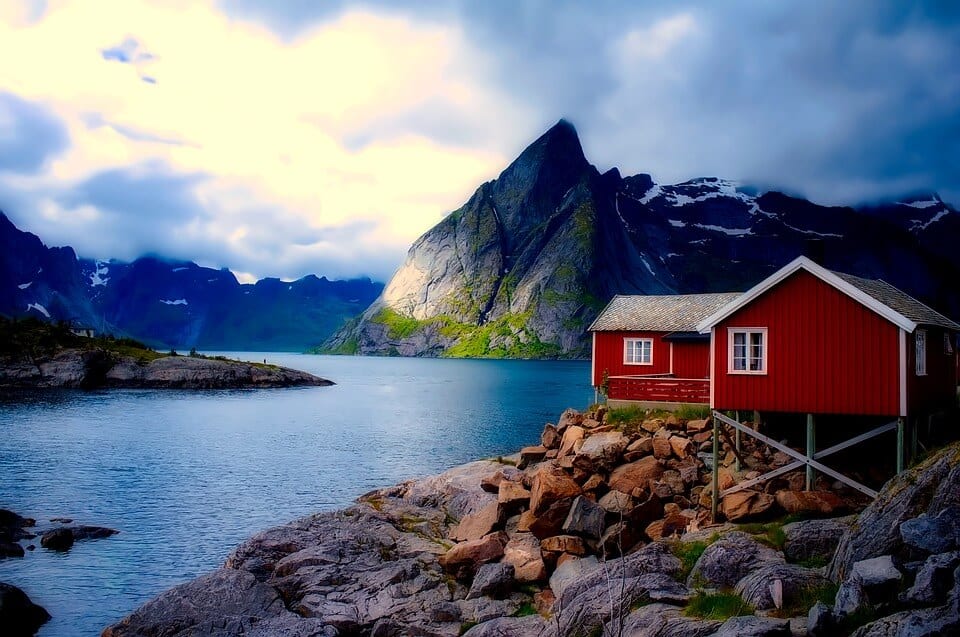
When is the best time to hike in Norway
Norway has four seasons, and as mentioned before, in summer you might experience all four in a day. As of this, the hiking season in the mountains is short, and the further north you go in the country the shorter it gets.
Normally you can go hiking between May and September, but depending on the height of the hike and how far north you are, this period shrinks. Some hikes are just not safe when there is snow.
Once I tried to hike Trolltunga, it was late April in the Easter holidays. Spring had arrived early and the snow was gone. My friend and I were super-excited by going hiking to this iconic place. We had hardly hiked for an hour when we got to the top of the first hill and saw nothing but snow. Deep, white snow. Everywhere.
Our concerns were confirmed by a Red Cross worker that came by on his snow scooter. He sent us straight down again together with some Polish tourists. There was nothing to do but to turn around. That was rule number 8.
What to bring when hiking in Norway
Hiking in Norway means you need to be prepared for all sorts of weather and conditions as it can change relatively quickly. There are a few things you should always make sure to bring with you.
In the case of emergency
First of all, the number you need to save for possible accidents is 112. This is the emergency number for the Norwegian police. In case you need rescue, they will coordinate everything from there. This is free in Norway.
Many places in the mountains, there is no mobile network. Luckily, there are a few tricks you can do to contact emergency if you need assistance on your hike and there is no mobile network.
The following three tips require a mobile phone with a charged battery:
- Turn off your phone, take out your SIM-card, turn on the mobile, call 112.
- Download an app called “Hjelp 113”. You will need to add your phone number and accept the app to get access to both your position and SMS service to make it work. By calling 112 from the app, the emergency services will get your exact position. This makes it easier to find you if they have to pick you up by a helicopter or on foot.
Note: I cannot confirm if this works with other than Norwegian phone numbers.
- The final source is an SMS service (requires the mobile network to function) called RescueMe. This is a service from the Norwegian Red Cross and works in two ways.
- If others report you missing, the emergency service will send you an SMS. You only have to reply “Ja” (“yes” in Norwegian) to the SMS if you need help. As a result, a rescue mission will be organized to find you. They will be able to search for your location through GPS technology.
- If you call 112 yourself informing that you need rescue, they can send you the same SMS to track your location. By replying “Ja” the same actions as above will take place.
Note: I cannot confirm if this works with other than Norwegian phone numbers. There is also a weak point here, you need phone network, and you need to be able to reply correctly to the SMS.
IF YOU GO CAMPING; MAKE SURE YOU READ:
- The ultimate guide to sustainable camping gear
- Best tents for camping with dogs
- Best instant quick set up tents
What to bring in your daypack
Now we have been looking at clothing, and of course, you need to make space for the extra layers of clothing in your daypack.
However, there are a few more things you need. Both for your amusement, energy levels, and in case you get lost. The latter is especially important if you do a less frequented trek.
- Lunch pack (bring a good amount of food, it is better to have a little more than less)
- Snack (nuts and fruit are good snacks that will keep your energy levels up
- Reusable water bottle with enough water (while many hikes in Norway have access to clean, natural water sources, not all of them do. You should bring at least 2 liters per person)
- Eco-friendly sunscreen and sunglasses (in case of a sunny day)
- Headlamp or flashlight with extra batteries (in case you get lost and don’t get back before dark)
- Basic first aid kit (in case you get injured or need to help others that are injured)
- Mobile phone (For photos, but also in case you need to contact emergency services)
- Solar-powered portable power bank
- Camera with extra battery and memory card (to make sure you don’t miss out of any of the incredible photo opportunities)
To pack the best way and ensure that your day pack doesn’t feel too heavy, The Norwegian Trecking Association recommends that you put the heavier items close to your back or high up in the backpack. Unless your daypack is waterproof or you have a rain cover for it, you should pack items in waterproof bags.
Find the best eco-friendly backpacks here.
What to wear when trekking in Norway
First of all, when heading out on the Norway hiking trails, you should always have good hiking boots. It is important that they have been used before. New hiking boots are terrible for blisters, and I can assure you that you don’t want to be far up in the Norwegian mountains with aching blisters on your feet. For this reason, you might even want to look into a pair of quality insoles for hiking boots.
If you are going on a shorter hike, you can wear good sneakers as an alternative.
You should always wear layers of clothes when you go hiking in Norway. Even though you start your hike with light clothing, you should put layers in your day pack in case the weather changes so you always stay warm when hiking.
Recommended layering:
- Inner layer: wool
Wool transports the humidity out of the body. That’s why it will keep you warm even though it gets wet. If it is too hot to wear wool when you head off, bring long, wooly underwear in your day pack just in case.
- Middle layer: wool or fleece
It is recommended to rather wear multiple thin layers than one thick woolen jumper. This is because the middle layer should transport the humidity further out to the outer layer of clothing. Like this, you stay warm and dry. The middle layer works as an isolation.
- Outer layer: waterproof windshield
The outer layer should always be windproof and preferably waterproof. This way the wind and rain won’t get into the other layers of clothing and it will keep you protected from the cold outside.
Finally, you need to think about covering your head, neck, and hands. Even on a warm day, it can get windy, but a hat can also protect your head from the hot sun.
How to be a responsible hiker
While trekking in Norway is an incredible experience for any outdoor enthusiast, I want to emphasize the importance of being a responsible hiker.
I will highlight a few important things to remember before you head out hiking. Mainly to respect nature, animals, and people. It shouldn’t be too hard.
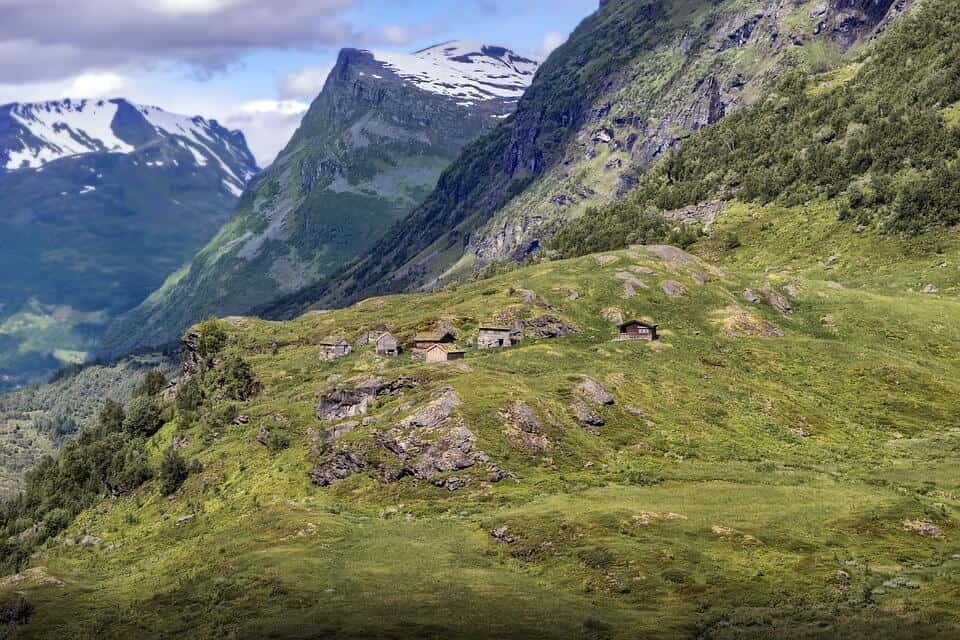
Bring your waste with you back from the hike
Nature is not going to stay beautiful forever unless we respect it and look after it. Large amounts of people walk the same treks and they bring their lunch, drinks, and snack wrapped in all kinds of non-organic wrapping. If this is not brought back down from the mountain, it will all pile up and destroy the trails completely.
Places like Mount Everest is already experiencing a terrible overflow of over 30 tons of waste covering the trail. Even though there is a long way for the Norway hiking trails to reach that, we all need to take our part of the responsibility.
Therefore, always bring your own trash with you back from the hike. Further, you could also pick up any pieces of rubbish you might see on the trail. This way, you make sure your footprints are not only as small as possible but also being positive.
You have probably all been there (it can’t only have been me this has happened to) where you see a piece of plastic from your lunch fly away. Too fast for you to catch up with it and bring it back where it belongs. So, if you are unlucky with one piece of non-organic waste but pick up someone else’s, at least you have done something.
I believe we all can make a little difference, so if we all focus on keeping those trails clean, we do make a big difference. Not only for nature but also for future generations – and the locals.
Respect the marked trails
Further, I want to mention the importance of staying on the marked path. Many places you are not meant to go outside as it can disturb the natural fauna. Respect that.
In Norway, nature is free to enjoy for everyone.
However, a lot of the land is used by farmers, among other things, to herd their sheep. With increasing numbers of tourists hiking off track, they end up having to move to other fields. But what when there is no more land to herd?
An important part of being a responsible traveler is to act as a visitor.
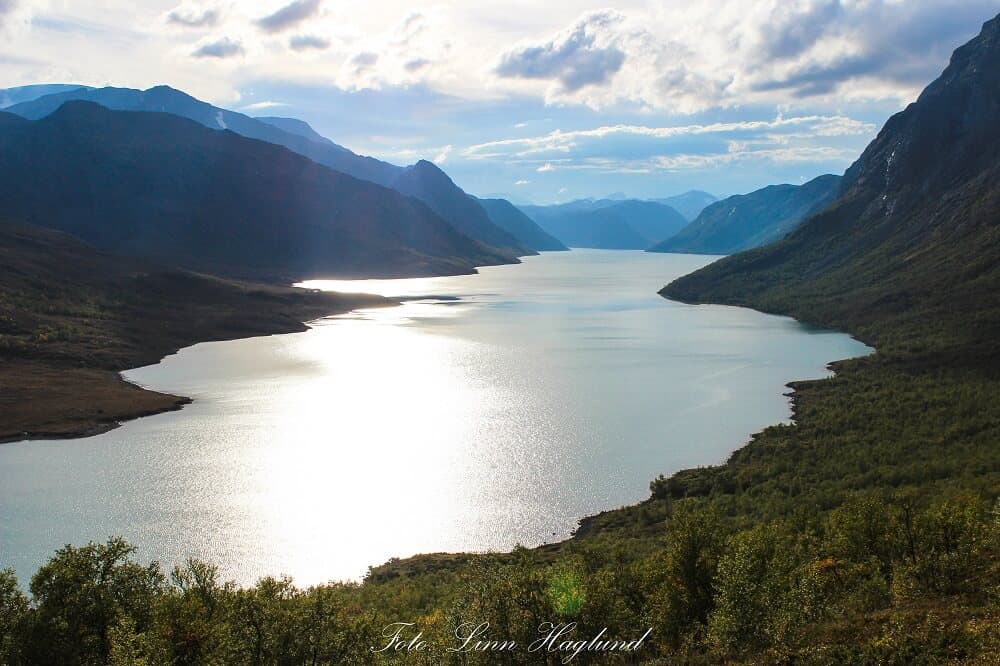
Don’t do silly things
Silly things, what? Simple as this: no stupid stunts for the Gram and respect the Norwegian Mountain code and you are set.
The fact is that the Red Cross and Norwegian Search and Rescue (Norsk Redningstjeneste) are rescuing the double amount of people now than only ten years ago, and numbers are increasing. The people rescuing tourists in the mountain often risk their lives. Further, we have to remember that they also do this as volunteers.
Insane amounts of money earned through private donations and campaigns where the involved sell advent calendars etc. go to rescue people in need as well as necessary training.
Being rescued in Norway is free.
The volunteers are not only working to rescue tourists but also Norwegian people in need. This includes missing people and people in extreme danger. They save people on sea and land and use boats, helicopters and motorized overland vehicles as needed.
To be honest, they do a heck of a good job. Also, they do an incredibly important job. So if you ever are in danger, they will do anything to save your life.
Therefore, before you do silly things, think about if it is worth risking those people’s life and time with family and friends. If it is worth silly amounts of money collected from locals. Just for the best Insta photo to receive all those likes.
Now, let us look at the top hikes in Norway according to myself and fellow travelers.
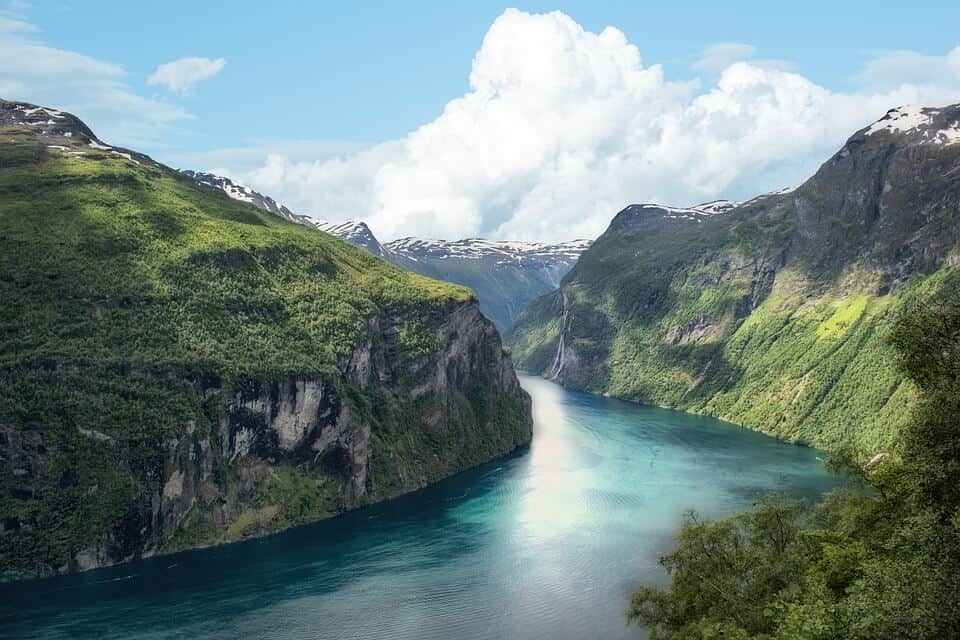
Best hikes in Norway
St. Olav’s Pilgrimage Route
The St. Olav’s Way is without a doubt one of the best hikes in Norway. It starts in Selånger, on the east coast of Sweden, and ends at Nidaros Cathedral in Trondheim, on the west coast of Norway.
The trail follows the road King Olav Haraldsson traveled in the summer of 1030 when he came back from exile in Russia to reclaim the Norwegian throne–and bring Christianity to Norway. The 564 km (350 miles) long pilgrim path runs from coast to coast – through two countries – in the footsteps of Saint Olav.
Although Norway Tourism is promoting pilgrimage routes that are entirely within Norway, e.g. from Oslo to Trondheim, the actual path that Saint Olav took is this one.
Pilgrimages to the Saint’s burial place began almost immediately after his death in the 11th Century, but pilgrimages were banned with the advent of the Reformation, and the St. Olav’s Pilgrimage route fell into disuse.
Now, Sweden and Norway are cooperating to groom and mark the various trails to Trondheim through the two countries. Detailed maps are available, and there are lists of accommodations along the route that you can book in advance. Obviously, you’ll need to do this, or bring a tent. Both Norway and Sweden are very liberal about allowing you to camp almost anywhere. And, there are sometimes rough shelters along the way that you can use.
In general, the path is well groomed and marked, and consists mostly of rolling hills. No mountaineering skills needed, although you will perhaps need to occasionally ford a stream. Get ready for one of the best hiking trails in Norway!
By Tom of Travel Past 50

Preikestolen hike
One hike that should be on everyone’s Norway hiking list is Preikestolen. It’s a much more beginner-friendly hike that many of this Nordic nation’s outdoor offerings, making it a great hike for any newbie adventurers.
Preikestolen (also known as Preacher’s Pulpit, Preacher’s Chair, or Pulpit Rock) is a massive natural rock outcropping, much like the Instagram-famous Trolltunga. It stands over 604m (1,982ft) above the Lysefjorden and sees over 200,000 visitors each year.
Located about an 8-hour drive west of Oslo, the hike to the Preachers Chair is only 90-120 minutes each way. While there are a few steep inclines, for the most part, it’s a relatively easy — but beautiful — hike.
Reaching the top, you’ll be rewarded with some incredible views that are well worth the effort!
Admission to hike is free, though if you come with a vehicle there is a 200 NOK parking fee. Located in the parking lot, you’ll also find bathrooms, a place to fill up your water bottle, and a restaurant.
If you’re going to visit Preikestolen, you’ll notice that there are no drones and no camping allowed right near the top. Please be respectful and follow these rules.
Also, there will no doubt be a queue for photos at the top so make sure you’re considerate and respectful of everyone waiting. It’s an amazing view that should be enjoyed by everyone, so snap your photos and then make way for your fellow hikers.
By Chris of Lessons Learned Abroad
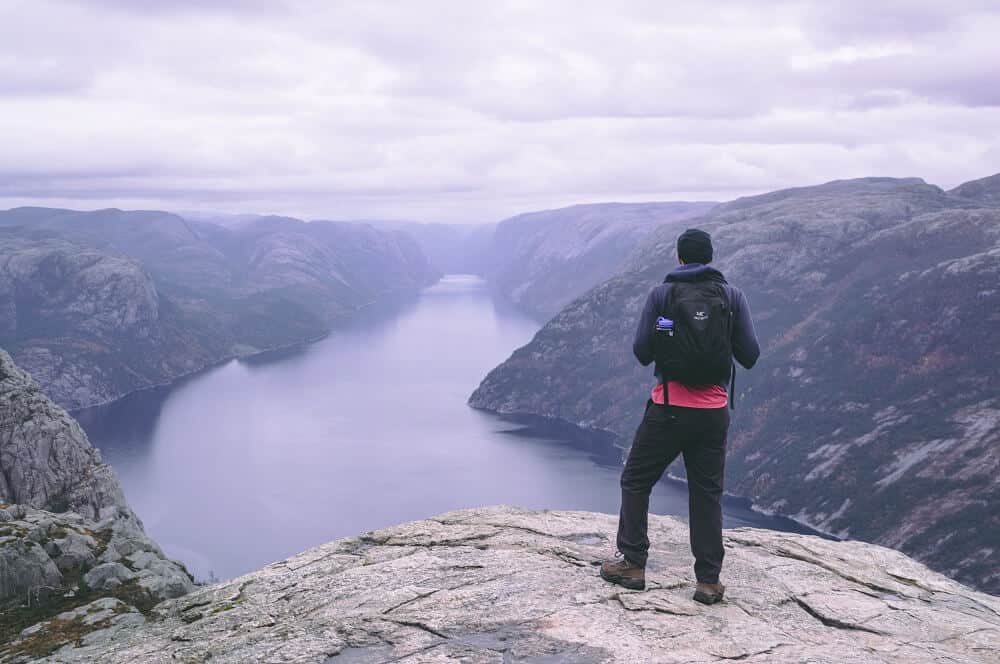
Ryten and Kvalvika beach hike, Lofoten islands
Lofoten landscape is truly unique with rugged peaks rising from the wild waters. The islands offer many hiking opportunities hence it is not easy to pick just one hike and call it the best. I decided to choose a hike that combines conquering a mountain with a view to a white sanded beach and then descent to that very beach, to have a dip if you dare.
Ryten mountain and Kvalvika beach is a moderate circular hike just over 7km long. It takes about 5-6 hours to complete or longer if you plan to spend more time enjoying the beach.
From E10 turn onto Fv808 towards Fredvang. Park at the parking bay in Bergland from where you can see a signpost to Ryten. The path is unmarked, initially follows the tree line and then becomes clearer and easier to navigate.
Some sections of the trail are wet and just a bit steep but otherwise there are no technical difficulties. Once you are near the top you get the first glimpse of Kvalvika beach. Keep walking until you get to the cairn – you are then at 543masl.
The way down to the beach is steep and requires care. However, the view of the beach rewards all your efforts. Enjoy the beauty of this Arctic beach! Lofoten islands indeed have some of the most beautiful beaches in the world and some of the best hikes in Norway!
One thing to bear in mind is that to return to your car, you will have to hike for another hour on rocks, mud and planks. Not easy or relaxing walk. Once you are on the road continue for another 15 minutes to the starting point.
To protect the fragile nature of Lofotodden National Park, always keep to the path and carry your rubbish.
Beata & Ela of Stunning Outdoors
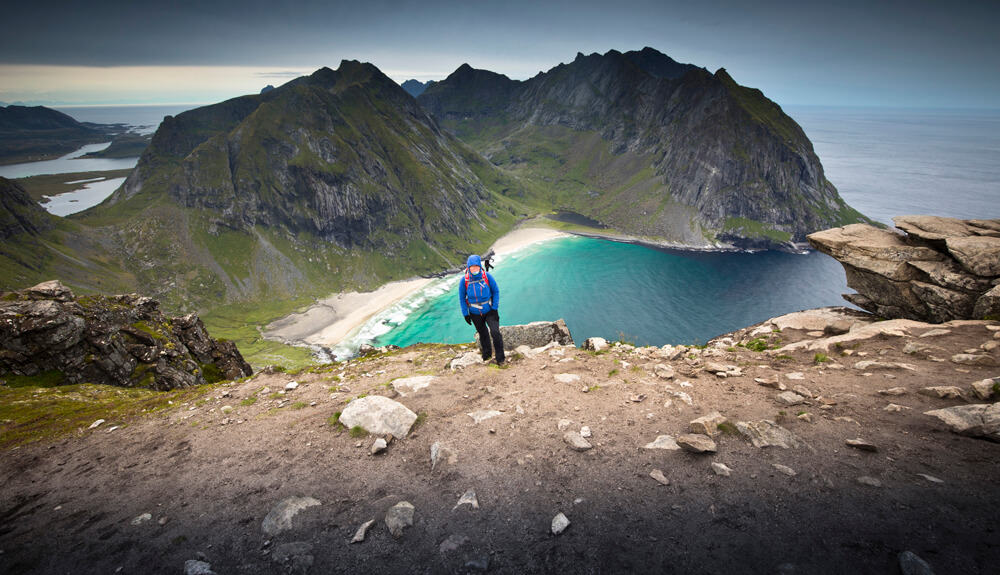
Trolltunga Hike
Trolltunga Hike (Troll’s tongue hike) is one of the most awe-inspiring hikes in Norway. Located 1100 meters above sea level you can expect lofty and spectacular views along the whole trail, not just the endpoint! You will pass a number of deep blue fjords, and dramatic mountains making this demanding trek totally worth it.
The hike is a total of 27km long, with an ascent of 900 meters, and takes an average of 10-12 hours to complete. The trail is clearly signposted and is one of the most popular Norway hiking routes both with locals and tourists. The first km is the most difficult and after this the trail levels off more.
The most important thing to be aware of is the weather, it changes rapidly so be prepared for all eventualities! I started in shorts but a rainstorm hit so I ended up in several layers by the end of the 12 hours. Bring plenty of food and drinks and always be mindful of daylight hours.
The trail starts in Skjeggedal, but the closest town for accommodation is Odda, where you can get a bus or taxi to the trailhead. Hiking season is from June until the end of September, but remember to start the hike early at around 8 am so you can complete the trail before dark.
Due to the amount of snow, it is recommended that you join a guided hike with Trolltunga Active or Trolltunga Adventures if you want to hike the trail outside of this season.
Trolltunga is one of the most iconic hikes in Norway, and I would be surprised if you haven’t seen the iconic photo from the top of the hike!
By Roshni of The Wanderlust Within
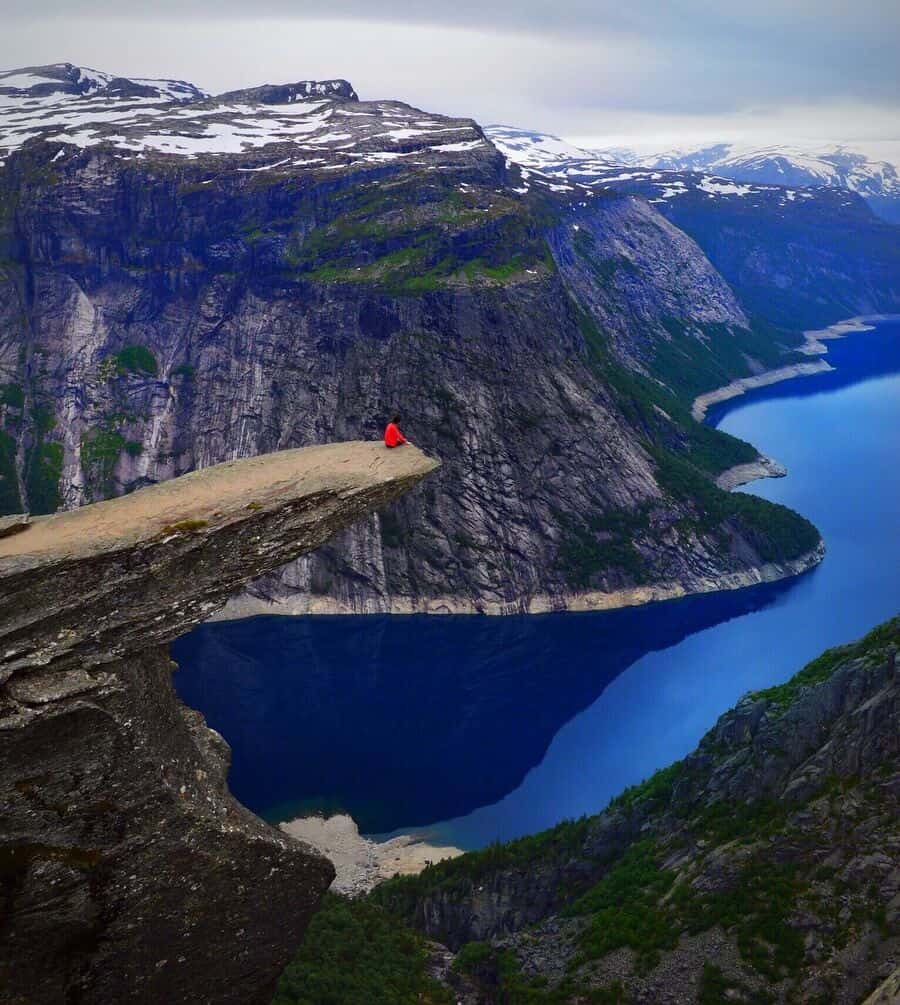
Besseggen ridge
One of the best hikes in Norway is definitely Besseggen ridge in Jotunheimen National Park. It is a 6-8 hours hike one way and requires a minimum level of fitness to enjoy.
Either way, you need to start from Gjendesheim. You can hike straight from there and across the ridge to Memurubu, sleep there and either hike back or take the ferry back to Gjendesheim the next morning. This is the most scenic route as you walk down the ridge and get the best views along the trek.
The most popular route, though, is taking the ferry from Gjendesheim to Memurubu in the morning and do the trek back.
The ridge itself is quite steep and with 700 meters straight down to Gjende Lake on one side and 300 meters straight down to Bessvatnet Lake on the other side, this is Norway trekking at its best.
During the whole trek, there are places to stop for your lunch or a snack, but you need to make sure to bring enough water, snack, and food to keep energy levels up during the whole day.
Close to Gjendesheim there are numerous hotels and camping grounds to stay overnight to make sure you can start the hike early.
The easiest way to get there is by car. Nevertheless, there are daily buses from big cities like Oslo, Trondheim, and Bergen.
Get ready to explore one of the absolute best hiking trails in Norway!
By Linn of Brainy Backpackers
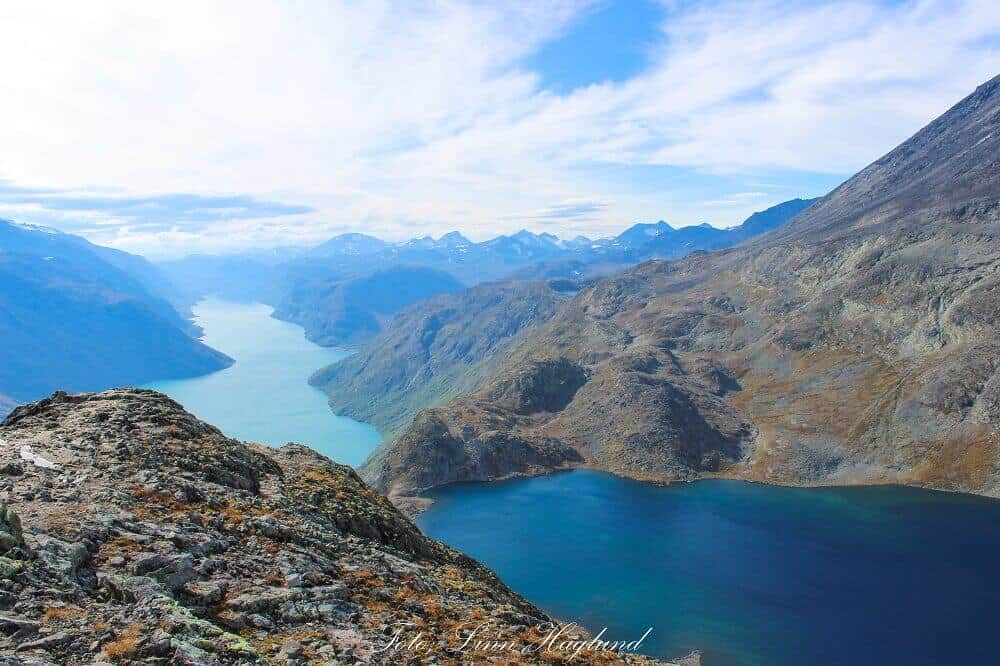
Molden Hike
You are not likely to find this hike on any tourist maps or guides. In fact, this whole fjord of Norway is relatively unheard of compared to the popularity of some places in Norway. Molden summit delivers the most spectacular fjord views in all of Sogn and an astounding place for walking in Norway.
The summit is marked with a mountain shelter and from here you get 360-degree views with fjords in all directions. The water below is so turquoise it will take your breath away. If you’re feeling brave, make it a backpacking trip, sleep under the stars, and wake to the most stunning sunrise of your life.
Molden is without a doubt one of the most beautiful places in the world but the view must be earned. This hike requires a strenuous 4-hour roundtrip trek through the forest and up through boulder fields.
Start this hike from Mollandsmarki road. This road is marked with a large yellow sign when driving north along the R-55 from Sogndalsfjora to Marifjora. Turn right (east) at the sign and you’ll quickly find the large dirt parking area.
Get there early to secure a parking spot and please be sure not to block the road. The path is well worn to the summit and is often marked with red spots on the trees.
Molden Hike is one of the top hikes in Norway not only because of its views but also because it is not the common tourist choice.
By Gabriela of Nomads With a Purpose
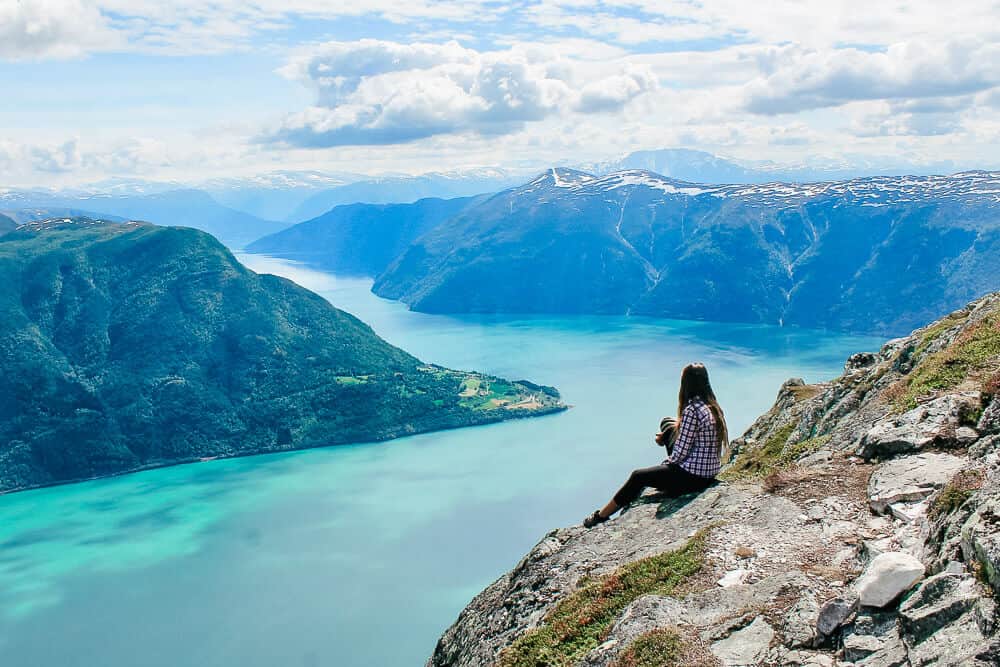
Florli 4444
Hiking Florli 4444 has got to be one of the most unique hikes we’ve ever done. Florli 4444 is the world’s longest wooden staircase, with you’ve guessed it, 4444 steps!
This wooden staircase, with the most outstanding views, follows the old pipeline and trolley railway up the mountain, built to service the old hydro-electric power station. The hydro-electric power station has long since shut down, but the staircase remains as an interesting and unique hike in Norway.
Florli 4444 can only be accessed via ferry from the Lysefjord. We traveled from Stavanger to Lauvik by car, where we caught the ferry to Florli. The ferry takes about 1.5 hours.
Once off the ferry in the tiny village of Florli, the climb begins. Two hours of climbing steps to make it all the way up this wooden staircase.
It’s hard work, but the views are spectacular from the very start, and somehow keep getting better. As you climb higher, you’re looking straight down into the Lysefjord.
It is not recommended that you descend the steps, as it is deemed too unsafe, so there is a different route back to Florli.
We followed the Rallerstein trail, which was the path used by the people employed to build the hydro-electric power station. The route back down takes approximately three hours.
It takes around five hours to hike Florli 4444, but this is a full day trip due to the travel involved. Hiking Florli 4444 is a must-do hike in Norway when in the Stavanger area.
By Nicky of Go Live Young
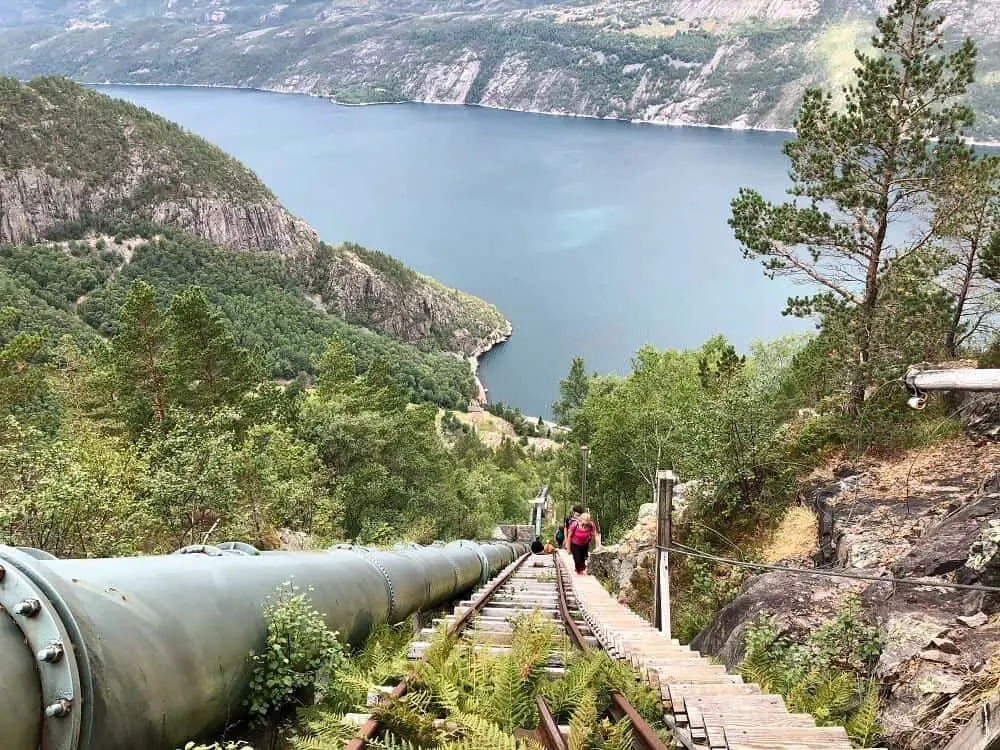
Gaustatoppen Hike
Gaustatoppen Hike is worthy among the best hikes in Norway. First of all, because it is possible to do for persons of all ages (with a minimum requirement of fitness), but nonetheless because of its impressive views.
Gaustatoppen offers 360 views of a 6th of Norway. You can see 60 000 square meters of the country from the top. That is more than the size of Denmark. And you know what? This is the highest peak in southern Norway with its 1883 meters above sea level.
The easiest way to start the hike to Gaustatoppen is from Stavsro parking. The trek is steady on rocky ground with constant views. Anyhow, it is recommended to wear good footwear, preferably hiking shoes. There is no shadow along the path, so make sure to cover your head when the sun is out.
Like any other day hike, you should bring a day pack with water, snacks, and food plus the obligatory layers of clothing for potential weather changes. At the top of the trail, you can use the toilet at the mountain café where you can also buy drinks and waffles.
By Linn from Brainy Backpackers
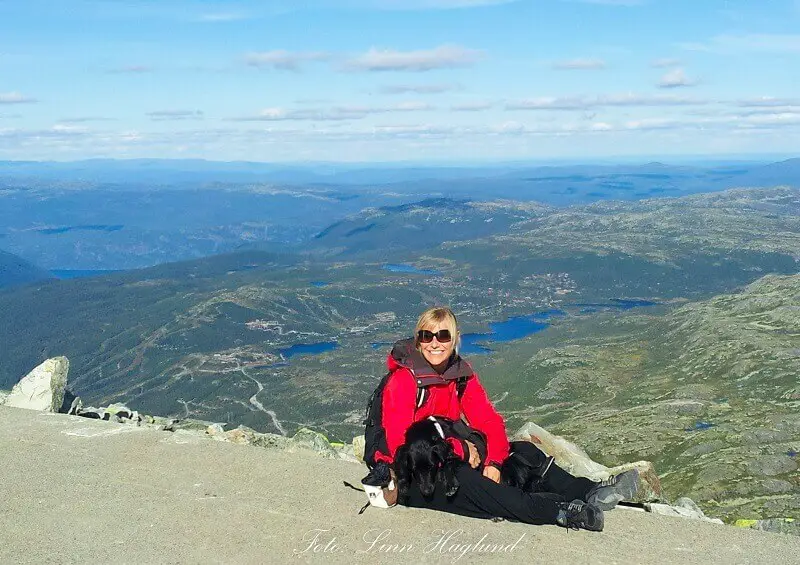
Kjeragbolten
Standing on Kjeragbolten was the highlight of my trip and another iconic hike in Norway. The hiking trail goes through beautiful meadows, streams, snowy and rocky areas and you will encounter some waterfalls as well.
No need to carry lots of water on this hike, as you will be able to refill your water bottle on several occasions from the stream water. It is lovely and refreshing! The hike is a bit challenging and good hiking boots are definitely recommended.
Once you get to the top you will have to make the decision if you will risk your life standing on Kjeragbolten or not. It is 1000 meters above Lysefjorden and only a step is the difference between life and death. Standing on it was a great bucket list experience for me, something I will always remember.
However, if you don’t feel confident about it, there is no shame giving it a miss. Doing the hike there is still a fun activity for nature lovers, as you are surrounded by beautiful scenery. The 12 km hike can take 5-8 hours.
By Eniko of Travel Hacker Girl
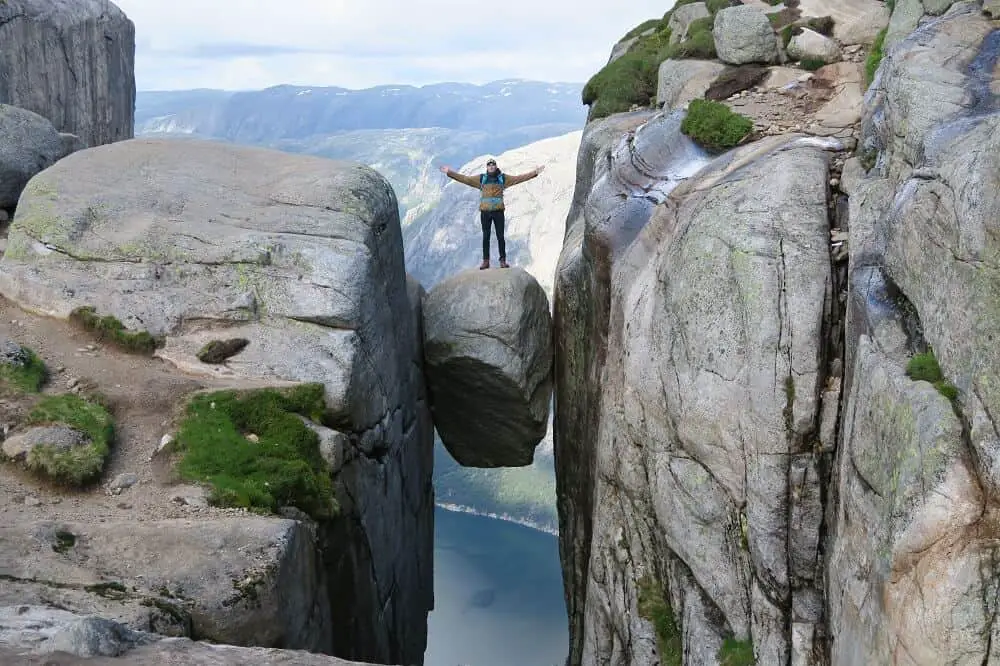
Vidden Trail
One of the hardest but also most rewarding hikes I have done in Norway was the Vidden Trail. Located just outside Bergen, the Vidden Trail starts on the top of Mount Ulriken and ends up in Bergen – you can either stop at the funicular base on Mount Floyen or continue down, to the city center.
From Bergen it is quite easy to get to the cable car station, you can either walk or take bus number 2. If you are brave, you can hike up to the start of the trail. However, that will add at least 2 hours to the hike and it’s all uphill. For beginners, the cable car is the best way up to the start of the path.
Whilst the trail is not very difficult, it is 18 kilometers long and it follows uneven mountain rocky terrain. I completed it in just over 5 hours, and I had to take the funicular down, I wasn’t able to walk any further.
The Vidden Trail is very beautiful and offers stunning views towards Bergen and beyond – the fjords. Whilst there are no shops or any places to buy snacks on the way, about halfway through there is a natural lake where you can fill your bottle with crisp fresh water. Vidden Trail is a good spot for walking in Norway.
By Joanna from The World in my Pocket
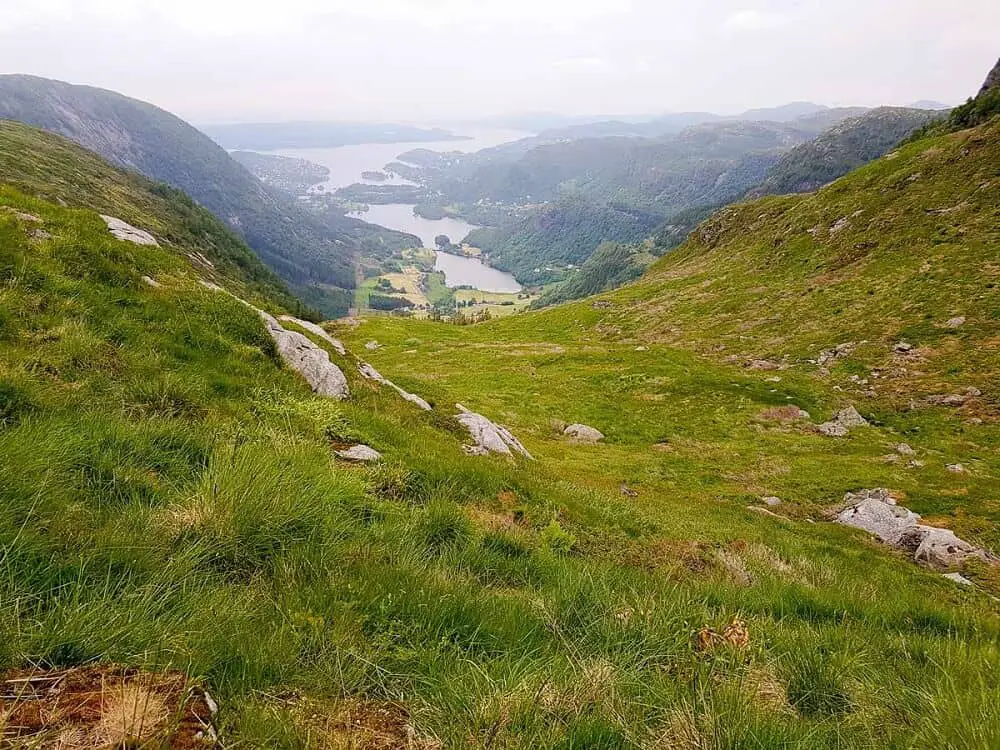
Plan your trip to Norway
Norwegians tend to be friendly when it comes to helping you out. Once my friend and I got lost and drove straight onto a ferry where the road ended. Yes, we drove onto a ferry. One of those little ones crossing the fjords in western Norway that probably fitted 8-10 cars altogether.
As we got directions through the car window from the ferry employee, he looked up and said “Ups! The ferry is moving! I guess you will get a free ride to the other side of the fjord and back again.” It was only a short ferry ride, yet mesmerizing. Half an hour later we were off in the right direction again.
Anyhow, unless you cruise the Norwegian fjords, I recommend you start planning your trip to Norway with Lonely Planets guidebooks. That way you don’t need an internet connection to figure out where to travel to next. I have traveled the world with their guide books and explored many offbeat places with their tips. You get great advice from traveler to traveler and a good selection of accommodation that you can book directly on Booking.com.
A good way to travel around Norway is by car. This way you can get to offbeat places that are hard or even impossible to get to with public transport. I usually use Rentalcars when I travel.
Did you like this post? Pin it for later!
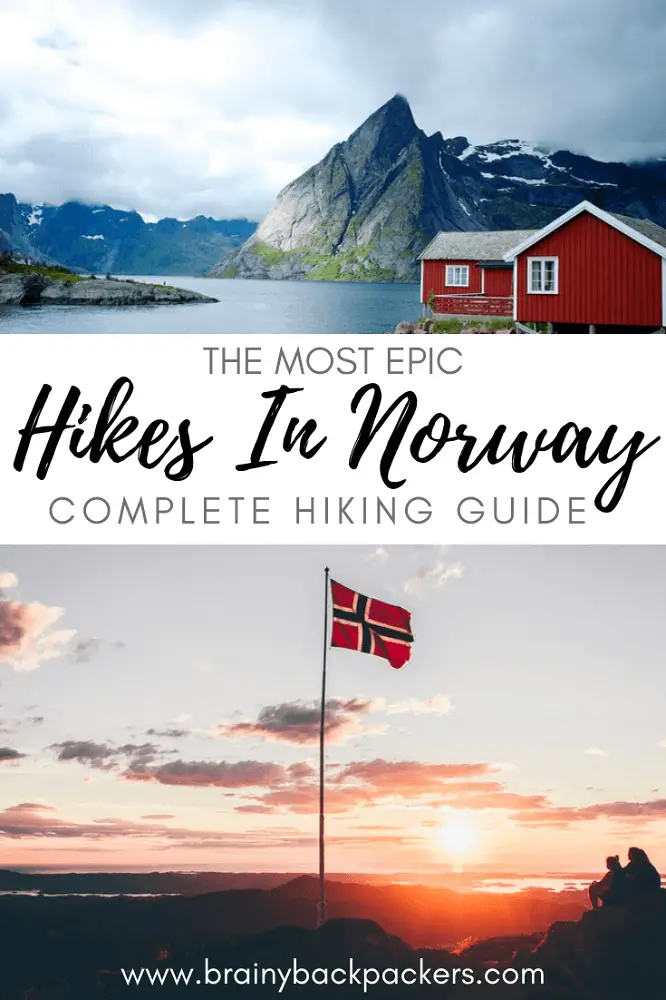

Great post Linn and well done to everyone who contributed! I didn’t realise that you learn the 9 rules in school – briliant! We used to learn things like how to recognise from the tree and the starts where north is. Now I can use this knowledge to always find my way to Norway hahaha we loved our time in Norway! The endless hiking oportunities!
Hi Beata, thank you very much! Yes, it is taught in school, at least it was when I was young:) Great knowledge to find out where north is too, though! Especially if it means you find your way to Norway and good hiking hehe
Great post. Very informative. And the pictures!!…I just want to take the next flight to Norway right now!
Thank you! It is great that you find value in the article, and it is absolutely true that Norway is beautiful:) Let me know if you go one day, I would love to hear about your adventures!
I will definitely be posting about an extraordinary adventure like Norway! I’ll use your blog for reference when I plan.
Appreciate that 🙂
Some great places left to be explored and it would be a great pleasure hiking to atleast one of these places looking forward to compplete some hikes in the coming time and also share this with my mates for their reference as well.
Hi Kanika, I’m glad you found some new inspiration for hiking in Norway! Hope you enjoy your hiking experience:)
I LOVED reading this post. I’m super into hiking and Norway is on the top of my wishlist! There are lots of great tips in this article like getting rescued by helicopter is free. Its nice to know thats there but I agree, no stupid stunts for the gram!
Thank you! Yes, it’s all about being responsible:)
Such an insightful post and so many great tips for hiking! Norway is one of those countries we’ve been dreaming of visiting for so long, pinning this for when we finally do
Thank you so much! It’s truly a hiking paradise:)
I loved Norway when I visited. You have outlined some awesome hikes here. I would love to do the Gaustatoppen Hike as that looks like my speed. I would be terrified to do the Kjeragbolten Hike. I would not be brave enough to stand on that rock!
If you are scared of heights Gaustatoppen is a good pick, though the last bit from the café and out to the “top” made my vertigo take control over me. Some of the boulders you walk on are loose and it does go straight down on both sides.
I would love to visit Norway—it seems like such a beautiful country. All these hikes are fueling my wanderlust!!! I’m ready to book a trip!
I really hope you make it one day when travel is possible again:)
These hike trails are just so picturesque and magical, wow! I really need to make my way to Norway some day. Trolltunga Hike took my breath away, I would love to see this person!
I really hope you make it as soon as travel is an option again!
We are coming to Norway to elope. We will be by Stavanger. Any easier hikes (in a dress lol) or outdoor spots you’d recommend? I’d love to do some of these listed but not sure time or hiking in a bridal gown would work. Thank you!
Hey Kristin, I do not recommend hiking in a dress or bridal gown. When you head out on a hike it is important that you are prepared with the right gear so you do not put yourself or others on the trail in danger. There is plenty of nice nature you can drive to from Stavanger for pictures in a nice dress, but better not go on a hike.